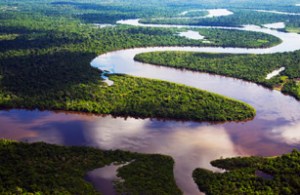
Paul Harris/JAI/Corbis
The originally published version of this story incorrectly stated that a joint Finnish-Russian forest conservation project in Russia includes a Russian NGO with five employees who have a combined salary of 300,000 euro a month. In fact, each employee earns around 300 euro a month.
(More on Time.com: See photos of forest defenders)
Ecocentric: How can Google Earth save the earth?
Nowadays satellite images are freely available but in developing countries people have no capacity or know-how about how to use them. This modern technology has decreased the gap between NGOs and pressure groups and big multinational companies. It’s greatly increased the capacity to influence business and politics. What we have done in Russia is used high-resolution satellite images and have marked out the valuable ancient forests or wilderness area and put this on the internet. When satellite images are updated it’s possible to see how the wilderness area is disappearing. Now, the high-resolution images do not update very frequently. But other satellite images update every day.
So it’s like a neighborhood watch program meets the National Security Agency (NSA)?
Yes. In Russia forest governance has basically collapsed because of lack of money and political problems. This technology allows even a very small group of experts to follow logging in sensitive areas and if they see something alarming they contact the companies that have leased the area and demand to know what’s going on, or they can contact the local forestry administration. The companies feel like they cannot hide. This is done in Russia by a small NGO of 5 people who have salaries of 300 euro a month.
Do you even need an NGO? Why can’t citizens monitor the forests on their own?
They can. But the problem is it takes a little expertise to interpret satellite images. You can train local level NGO workers to do that. Then maybe they set up a website that explains the satellite images and empowers local people to monitor them. What’s more, while Google and NASA and others provide satellite images for free, there are some commercial satellite companies that would charge citizens but have a deal whereby they give the images to NGOs for free. That’s another advantage.
Scientists publish studies of satellite images in the Amazon and other forests in major journals all the time. Don’t we already have a pretty good monitoring system through such researchers?
We don’t want to just identify that destruction is going on–everyone knows this is happening. We need to do something about that, and you must be able to confront companies with fresh, up-to-date satellite images so they cannot deny it. Western companies are very afraid of this sort of reputation, even Russian companies are becoming more responsive.
One problem with our system is that in some countries a lot of illegal logging is for individual and rare trees that can be used, for example, to make guitars or perfumes. For that we cannot study the logging but we can look at road construction and other things that would suggest these sorts of activities are going on.
What else can be done to help save the forests?
We can teach people this tool but to solve the whole problem is obviously more complex. In local level what is lacking often is local engagement. In Madagascar, for example, the government has tripled the protection area for forests. But hardly anyone knows this. It’s not always corruption, and not only poverty that lie at the heart of the problem. It’s often lack of ownership in implementing the protection.
(More on Time.com: See story on global illegal logging downturn)


